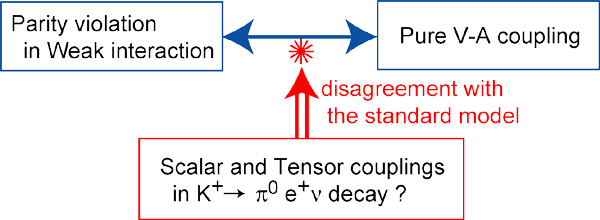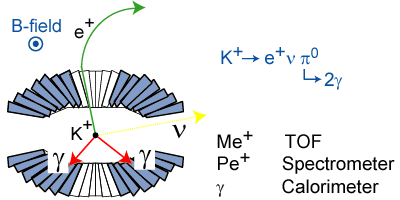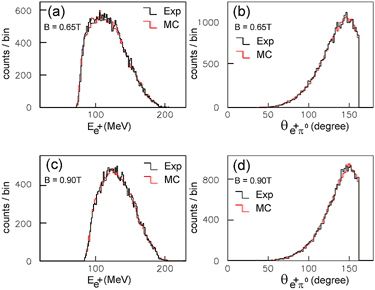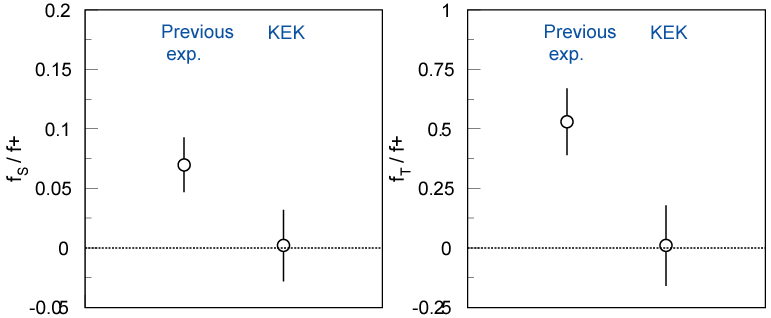
After the discovery of parity violation in nuclear decay of polarized
60Co in 1957,
many experimental and theoretical works have been
performed to understand the properties of the weak interaction. So far,
the interaction based on the pure V-A coupling feature have been
successful in explaining experimental observations in nuclear, meson ,
and muon decays. However, in 1991, scalar(S) and tensor(T)
interactions were observed in
K+ → π0e+ν
(Ke3)
decay[1].
The existence of these exotic interactions is
in distinct disagreement with the Standard Model and thus requires
an accurate experimental check. In order to check this important
result, we tested the S and T couplings in the
Ke3 decay using
the experimental apparatus which was constructed for a T-violation
search in
K+ → π0μ+ν
decay[2].

Ke3 events were identified by analyzing the
e+ momentum with
the spectrometer and detecting two photons in the CsI(Tl)
calorimeter. Charged particles from the target were tracked and
momentum-analyzed using MWPCs at the entrance and exit of the magnet
gap, as well as by the active target and an array of ring counters
surrounding the target. The e+s were selected by
measuring time-of-flight between TOF counters.
The photon energy and hit position were
obtained by summing the energy deposits and energy-weighted centroid,
respectively. The solid line in Fig.2(a,c) shows the e+
energy spectrum while (b,d) shows the opening angle distribution of
the accepted Ke3 events.

|

|
| Figure:1 | Figure:2 Experimental spectra(black line) of Ee+(a, c) and θe+π0(b, d) for Ke3 decay, and Monte Carlo simulation (red line). |
The most general Lorentz invariant form of the matrix element for the semi-leptonic K+ → π0l+ν (Kl3) decay is given by
![\begin{eqnarray}
{\mathcal M} \propto f_{+}(q^{2})[ (P_{K}+P_{\pi^{0}})
\bar{u}_{\l}\gamma_{\lambda}(1+\gamma_{5})u_{\nu}
]+f_{-}(q^{2})
[m_l\bar{u}_{\l}(1+\gamma_{5})u_{\nu}] \nonumber \\
+ 2m_{K}f_{S}\bar{u}_{\l}(1+\gamma_{5})u_{\nu} \nonumber \\
+ (2f_{T}/m_{K})(P_{K})_{\lambda}(P_{\pi^{0}})_{\mu}
\bar{u}_{\l}\sigma_{\lambda \mu}(1+\gamma_{5})u_{\nu}, \label{eqdal}
\end{eqnarray}](eqke3matrix.png)

The parameters are obtained to be [4],
| λ+ | = | 0.0278±0.0026(stat)±0.0030(syst) |
| fS/f+(0) | = | -0.002±0.026(stat)±0.014(syst) |
| fT/f+(0) | = | -0.01±0.14(stat)±0.09(syst) . |
